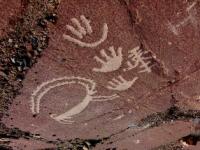You are here
Petroglyphs of Dashti Eymatk.

Trip to petroglyphs Tajikistan.
“If you follow the ancient maps written on the stars, no person will ever understand you. So if you could read these maps, would you follow them? And forever be misunderstood? Or would you close your eyes tightly and pretend to be like everyone else?”
C. JoyBell C.
Legend Rock State Petroglyphs Tajikistan.
A significant accumulation of petroglyphs is located 10 kilometers west of the village of Urmetan, the village council of Urmetan in the Aininsky district of the Sogd region. Located on the right bank of the Zarafshan River.
Level of Study Archeologist Mandelshtam A.M. discovered the site in 1953 during the expedition of the Verkhnezeravshan Party of the Sogdian-Tajik Archeological Expedition (Mandelshtam 1954).
He provided descriptions of humans, barely mentions animals and only pointed out that their “threedimensional” images are noted for their dynamics, in his article published in 1956.
An article devoted to a zoological interpretation of the Dashti Eymatk petroglyphs was published in 1982 (Sapozhnikov & Panfilov 1982: 71 - 76). The petroglyphs are drawn on rock fragments covered with a thick layer of desert patina.
There is a total of 124 petroglyphs, 85 of which are in 12 panels. They include mountain goats and sheep, deer, horses, dogs, snakes, leopards, wild boars, otter, humans, lines and weapons. Scenes occur: a dog chasing a mountain goat in the direction of a hunter armed with a bow; an archer and two goats.
A deer and a snake; a man holding his horse by the reins; a herd of nine goats and a deer chased by three wolves and a leopard; a battle between a goat and a wolf, etc. Humans are diverse. Some are armed with bows, and some are sexually differentiated.
A rock with a mountain goat in a linear style was discovered at Dashti Eymatk near a kurgan burial site in the vicinity of the village of Mindana Kamen in 1952. Animals images are in a linear and naturalistic manner.
Three drawings are carved in a contour style, some with partial infilling of the body. The technique used was pecking with a metal tool to a depth of 2 - 3mm. All images are covered with a dense layer of patina the same color as the rock surface.
According to Mandelshtam A.M., the Dashti Eymatk petroglyphs carved in a realistic manner would be dated to the middle-end of the 1st millennium BC.
Authority:
Bobomullo S. Bobomulloev.
Photos by
Surat Toymasov.







